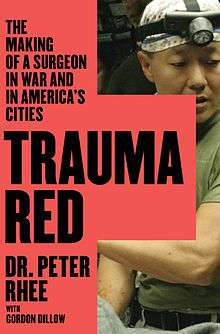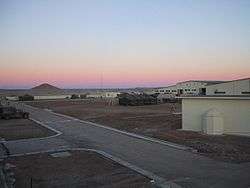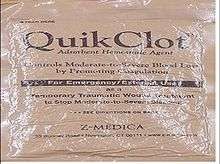Peter M. Rhee
| Peter M. Rhee, MD, MPH | |
|---|---|
|
| |
| Born |
September 18, 1961 |
| Allegiance |
|
| Service/branch |
|
| Rank |
|
| Commands held | Navy Trauma Training Center at Los Angeles County+USC Medical Center |
| Battles/wars |
Operation Enduring Freedom Iraq War |
| Awards |
|
| Other work |
|
Peter Meong Rhee (born September 18, 1961) is an American surgeon, medical professor, and military veteran.[1] During his 24 years in the United States Navy, Rhee served as a battlefield casualty physician in Afghanistan and Iraq.[2]
Dr. Rhee is the Chief of Trauma Critical Care and Emergency Surgery at the University of Arizona Medical Center in Tucson, Arizona and Professor of Surgery at the University of Arizona. In January 2011, Rhee was the Attending physician to U.S. Representative Gabrielle Giffords of Arizona as well as other victims of the 2011 Tucson shooting.[2]
Biography
Early life and education
Born in Seoul, South Korea, Peter Rhee lived for several years in Uganda as his father, also a doctor, worked in the Peace Corps. The elder Rhee moved the family to the United States when his son was 10 to get a better education. The family was raised in a small Pennsylvania town, south of Pittsburgh. His father was an anesthesiologist at Uniontown Hospital.[3] The younger Rhee graduated in 1979 from Laurel Highlands High School in Fayette County.[4] In 1983, he received his Bachelor of Science degree in Health Systems Engineering from the Georgia Institute of Technology.[5] In 1987, Rhee earned his medical degree from the Uniformed Services University of Health Sciences F. Edward Hebert School of Medicine. He also earned a master's degree in Public Health from the University of Washington Department of Health Services. In 1999, he earned a diploma in Medical Care of Catastrophes from the Society of Apothecaries of London.[6]
Memoir

On Saturday, January 8, 2011, Dr. Peter Rhee was called into work—on his first day off in weeks—to Tucson’s University Medical Center Trauma Center, where 10 gunshot victims were being rushed after a man opened fire on a crowd of people at a local supermarket. One of the victims was Congresswoman Gabrielle Giffords. It was a day the nation would never forget, but for Dr. Rhee, it was also just another day on the job, saving lives. In his gripping memoir TRAUMA RED: The Making of a Surgeon in War and in America’s Cities, Peter Rhee recalls that “challenging, exhausting, exhilarating, frustrating, heartbreaking, satisfying, bloody, bloody, bloody day at the office,” and the path that led him there. From his youth in South Korea and Uganda—where he once watched his surgeon father remove a spear from a man’s belly—to frontline surgery in Iraq and Afghanistan, to trauma centers on the urban battlefields of Los Angeles and Washington, DC, Rhee's stories are fascinating.[7]
“It took a long time to be convinced that I should write this book,” Rhee stated. He felt that the book would be looked upon as being egotistical by his professional peers. He states that he wrote the book to document from the medical provider point of view what actually happened when Congresswoman was shot in the brain and so that others could learn what a trauma surgeon is.
Personal life
Rhee met his wife, Emily, as he was completing his residency at the University of California, Irvine. They have two children.[8]
Military service

Rhee is a 24-year veteran of the U.S. Navy.[2] During a trip to China in 1998, he was selected to accompany U.S. President Bill Clinton as his designated surgeon.[10] In 2001, Rhee became one of the first American military surgeons to be deployed in Afghanistan at Camp Rhino, the first forward operating base to be established during Operation Enduring Freedom.[2] In 2005, Rhee was deployed to Iraq, where he established the first surgical unit in Ramadi.[2][9] His service awards include the Defense Meritorious Service Medal and the Navy Commendation Medal.[9]

As the Director of the Navy Trauma Training Center at Los Angeles County+USC Medical Center, Rhee became involved in an interbranch disagreement between the Army and Navy regarding the adoption of new hemostatic agents designed for battlefield treatment of severe bleeding. While the Army had adopted blood-clotting bandage called HemCon, the Navy and Marines instead opted for a different product called QuikClot. After testing HemCon at the Navy Trauma Training Center, Rhee concluded in December 2005: "I've tried every one of these products, many times, on many different kinds of wounds. For big-time bleeding – and that's what we're really worrying about here – HemCon doesn't work."[12] Though Rhee preferred QuikClot, he expressed reservations over its commercialization in 2003 because of the potential for misuse by untrained consumers.[11]
Rhee was appointed as Professor of Surgery and Molecular Cellular Biology at the Uniformed Services University of the Health Sciences and continues to consult for the Office of Naval Research and the Marine Corps War Fighting Laboratory.[10]
Civilian medical career
Rhee worked in the trauma centers at the Harborview Medical Center in Seattle and the Washington Hospital Center in Washington, D.C. In September 2007, he became the Chief of Trauma and Critical Care and Professor of Surgery at the University of Arizona in Tucson, Arizona. By that time, he had published over 200 articles in medical journals.[10] In July 2009, the University Medical Center was designated a Level 1 Trauma Center by the American College of Surgeons. Rhee stated that the center had become ranked among the top 10 in the nation.[13]
2011 Tucson shooting
In January 2011, Rhee became the subject of national media attention as the attending trauma physician for U.S. Representative Gabrielle Giffords, who had been shot in the head near Tucson.[14] Rhee was out jogging at the time of the shooting and had to rush three miles home and go to the hospital.[1] Rhee also held press conferences to update the public on her condition.[14] Upon observing that Giffords was still able to squeeze a doctor's hand, which most gunshot victims are unable to do, he became confident of her chances.[1] Rhee remarked, "She has a 101 percent chance of surviving. She will not die.[15]
On January 12, 2011, Rhee was met with cheers as he arrived at the McKale Center, while still dressed in scrubs and a white coat from the medical center, for a memorial speech by U.S. President Barack Obama.[16] Rhee was also invited to sit with First Lady Michelle Obama during a joint session of the United States Congress for the 2011 State of the Union Address on January 25.[17]
2011 State Dinner at the White House
On October 13, 2011, Dr. Peter Rhee and his wife Emily attended the State Dinner for the Korean President.[18]
2012 Commencement Speech
On May 12, 2012, Rhee delivered the commencement speech to the University of Arizona Class of 2012.[19] The theme of the speech was "Today is a Good Day". He spoke primarily about his experiences traveling, and why today is a good day. How to look at things optimistically.
2012 Hometown Hero and U.S. Air Force Thunderbird Flight
In April 2012, Rhee was selected as the Hometown Hero for the Thunder and Lightning over Arizona open house at Davis-Monthan Air Force Base. Rhee was able to fly with the Thunderbirds in an F-16 Fighting Falcon Jet.
Titles
- American Board of Surgery
- Fellow of the American College of Surgeons
- Fellow of the Critical Care Medicine
- Diploma in the Medical Care of Catastrophes
Research interests
Rhee's areas of research interest includes hemorrhagic shock, suspended animation for trauma, hemostatic agents, resuscitation immunology and formulation of resuscitation fluids, Traumatic brain injury, transfusion and coagulopathy, trauma training, and advanced portable electronic medical devices including ones for communication and documentation. His national interests includes improved trauma on the Indian reservations, improved gun control and prevention of gun violence, suicide prevention and finally improved disaster preparedness. As a founding member of the He is a founding member of the Tactical Combat Casualty Care Committee (TCCC) his research interests has continued to focus on saving combat casualties. He has served on numerous National steering committees and national trauma research committees including the Defense Health Board’s Subcommittee on Trauma & Injury as well as the Federal Drug Administration’s blood products advisory committee, the Resuscitation Outcomes Consortium’s protocol review committee and drug safety and monitoring board.
See also
Publications
He has authored over 340 peer reviewed publications and 20 book chapters and three books. His H index is 62 (Google scholar) and his publications are listed at: http://www.ncbi.nlm.nih.gov/myncbi/collections/bibliography/48789648/
- Rhee, Peter M.; Foy, Hugh; Kaufmann, Christoph; Areola, Carlos; Boyle, Edward; Maier, Ronald V.; Jurkovich, Gregory (August 1998). "Penetrating Cardiac Injuries: A Population-Based Study". Journal of Trauma-Injury Infection & Critical Care. 45 (2): 366–370. doi:10.1097/00005373-199808000-00028.
- Rhee, Peter M.; Acosta, Jose; Bridgeman, Amy; Wang, Dennis; Jordan, Marion; Rich, Norman (March 2000). "Survival after emergency department thoracotomy: review of published data from the past 25 years". Journal of the American College of Surgeons. 190 (3): 288–298. doi:10.1016/s1072-7515(99)00233-1.
- Gushchin, Vadim; Stegalkina, Svetlana; Alam, Hasan B.; Kirkpatrick, John R.; Rhee, Peter M. (May 2002). "Cytokine Expression Profiling in Human Leukocytes after Exposure to Hypertonic and Isotonic Fluids". Journal of Trauma-Injury Infection & Critical Care. 52 (5): 867–871. doi:10.1097/00005373-200205000-00008.
- Koustova, Elena; Stanton, Kathleen; Gushchin, Vadim; Alam, Hasan B.; Stegalkina, Svetlana; Rhee, Peter M. (May 2002). "Effects of Lactated Ringer's Solutions on Human Leukocytes". Journal of Trauma-Injury Infection & Critical Care. 52 (5): 872–878. doi:10.1097/00005373-200205000-00009.
- Wright, Franklin L.; Hua, Hong T.; Velmahos, George; Thoman, Dave; Demitriades, Demetrios; Rhee, Peter M. (January 2004). "Intracorporeal Use of the Hemostatic Agent QuickClot in a Coagulopathic Patient with Combined Thoracoabdominal Penetrating Trauma". Journal of Trauma-Injury Infection & Critical Care. 56 (1): 205–208. doi:10.1097/01.ta.0000074349.88275.c4.
- Rhee, Peter.; Eifert, Sandra.; Talon, Eric; Stanton, Kathy; Koustova, Elena; Ling, Geoff; Burris, Dave; Kaufmann, Christoph; Mongan, Paul; Rich, Norman; Taylor, Michael; Sun, leon (March 2000). "Induced Hypothermia During Emergency Department Thoracotomy: an Animal Model. Journal of Trauma Injury and Critical Care. 48:439-450". Journal of Trauma-Injury Infection & Critical Care. 48 (3): 439–450. doi:10.1097/00005373-200003000-00011.
References
- 1 2 3 Chang, Alicia (January 14, 2011). "Giffords' doctors balancing role as rock stars". Associated Press. Retrieved January 29, 2011.
- 1 2 3 4 5 Mehta, Seema (January 10, 2011). "Giffords' surgeon trained on the battlefield". Los Angeles Times. Retrieved January 23, 2011.
- ↑ Pickels, Mary (January 11, 2011). "Giffords' doctor was standout student at Laurel Highlands". Pittsburgh Tribune-Review. Retrieved January 23, 2011.
- ↑ "U.S. District Judge, Pitt. Native Killed In Arizona Shooting". WTAE-TV. January 10, 2011. Retrieved January 23, 2011.
- ↑ "Peter Rhee, MD, MPH, FACS, FCCM, DMCC" (PDF). Defense Health Board. December 9, 2010. Retrieved January 23, 2011.
- ↑ Melville, Nancy A. (January 25, 2011). "Dr. Peter Rhee: Battlefield Background Provides Composure Amid Tucson Shootings". Medscape. Retrieved January 29, 2011.
- ↑ Scribner, a division of Simon & Schuster; June 3, 2014; 978-1-4767-2729-5
- ↑ Medina, Jennifer (January 12, 2011). "Surgeon and Sudden Celebrity, and Trying to Balance the Roles". The New York Times. Retrieved January 23, 2011.
- 1 2 3 "Our Medical Staff: Peter M Rhee, MD". University Medical Center (Tucson, Arizona). Retrieved January 29, 2011.
- 1 2 3 "UMC, UA Appoints U.S. Navy Veteran Dr. Peter Rhee Director of Trauma". UA News. University of Arizona. September 27, 2007. Retrieved January 23, 2011.
- 1 2 Healy, Melissa (July 22, 2003). "Life-saving clotting powder heading to stores". Pittsburgh Post-Gazette. Retrieved January 29, 2011.
- ↑ Little, Robert (December 4, 2005). "Army's Costly Battlefield Bandage Raises Questions". Los Angeles Times. p. 3. Retrieved January 29, 2011.
- ↑ Riley, Katie (July 15, 2009). "UMC Trauma Center Receives Level 1 Verification". UA News. University of Arizona. Retrieved January 29, 2011.
- 1 2 Smith, Dylan (January 8, 2011). "Giffords shot in head; federal judge, nine-year-old, 4 others killed". Tucson Sentinel. Retrieved January 29, 2011.
- ↑ "Doctor says congresswoman has '101 percent chance of surviving'". Daily Mail. Associated Press. January 11, 2011. Retrieved January 29, 2011.
- ↑ Rose, Jaimee; Reagor, Catherine (January 12, 2011). "Giffords shooting: Barack Obama draws about 26,000". The Arizona Republic. Retrieved January 29, 2011.
- ↑ Camia, Catalina (January 24, 2011). "Giffords' intern gets special seat for Obama's speech". USA Today. Retrieved January 29, 2011.
- ↑ "White House. Expected Attendees Tonight's State Dinner".
- ↑ Camia, Catalina (May 12, 2012). "Dr. Peter Rhee to Undergrads: Travel, Today's a Good Day". UA News. Retrieved May 12, 2012.
Rhee P, Eifert S, Talon E, Anderson D, Stanton K, Koustova E, Ling G, Burris D, Kaufmann C, Mongan P, Rich MN, Taylor M, Sun L. (2000)Induced Hypothermia During Emergency Department Thoracotomy: an Animal Model. Journal of Trauma Injury and Critical Care. 48:439-450.
External links
| Wikimedia Commons has media related to Peter M. Rhee. |